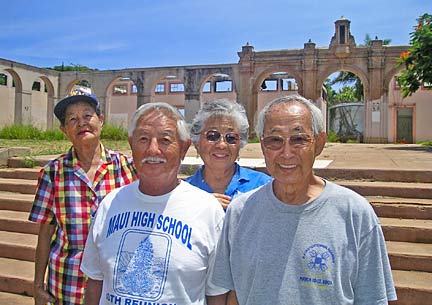
|
Campus to rise
from ashes
Alumni band together to turn
old Maui High into a bright
beacon honoring Patsy Mink
HAMAKUAPOKO, Maui » The high school that graduated several prominent Hawaii citizens, including the late U.S. Rep. Patsy Mink, is dying.
So scores of alumni have formed a foundation to preserve the historic site of the old Maui High School and rehabilitate its fire-ravaged administration building into the Patsy T. Mink Center.
Kokua connection
To help in the rehabilitation of the old Maui High School campus, contact Friends of Old Maui High School at P.O. Box 7921165, Paia, HI 96779; or at 808-877-2524.
|
"Keeping her memory alive and her goals alive is important," said Barbara Long, president of the Friends of Old Maui High School, a nonprofit group promoting the rehabilitation of the administration building. The building was designed by C.W. Dickey, known as the "father of Hawaiian architecture."
The 23-acre high school campus was developed in 1913 and closed in 1972, after a new Maui High School opened in Kahului.
Despite the fire in August 2004, the structure of the administration building remains intact, including the majestic arches, masonry walls, shaded walkways, and large windows overlooking a central courtyard.
In the early 1900s as many as 1,000 students were enrolled in Maui High, with hundreds of youths living in sugar and pineapple plantation homes clustered in laborers' camps, some riding railroad cars to school.
The multiracial, coeducational school also represented a break away from an agricultural plantation economy in which ethnic groups lived in segregated camps and ladies were directed toward work as homemakers, teachers, office clerks and librarians.
A 1944 school yearbook describes Mink, president of the student body and class valedictorian, as a "dynamic" person, "ever-busy with school government" who "adapts herself well to any occasion."
Classmate Harriette Holt, a retired Maui district judge, recalled that "Patsy was always very energetic, very outgoing."
Mink's brother, Eugene Takemoto, said his father, a University of Hawaii graduate, expected his children, including Patsy, to get a college education.
Spencer Shiraishi, a 1945 graduate, said he remembered competing against Mink in a speech contest when she was a senior and he was a junior.
After winning the contest, she offered words of encouragement to him.
"She said, 'Eh, Spencer, you keep it up. You got one more year to go.' That I never forget. That was nice of her," said Shiraishi, 79, a retired TV and radio engineer who coaches for the Maui Swim Club.
Mink was the first Asian-American woman to practice law in Hawaii and was elected to the Territorial Legislature in 1956. She was elected to the U.S. House in 1965, becoming the first woman of Asian-American descent to be elected to Congress.
Classmate Elmer Cravalho, a former state House speaker and Maui mayor, said one of the goals for the school is to serve as a memorial to Mink's accomplishments.
Other notable graduates include national swim champions Halo Hirose and Keo Nakama.
Part of the rehabilitated administration building and new buildings on the former school campus are also expected to provide social services for residents in need. Maui Mayor Alan Arakawa said the school is an ideal site for social and health services.
U.S. Sen. Daniel Inouye has helped to secure a $250,000 federal grant toward the restoration of the administration building to be used as the Patsy T. Mink Center. Meanwhile, a core group made up of graduates and friends of the high school, including volunteers from the nonprofit Community Work Day Program, are continuing to clean the campus and raise funds.
"Somebody has to do it," said Teruo Kakihara, 78, a 1945 graduate. "What a waste to have this rot. Once it's gone, it's gone."
E-mail to City Desk
[News] [Business] [Features] [Sports] [Editorial] [Do It Electric!]
[Classified Ads] [Search] [Subscribe] [Info] [Letter to Editor]
[Feedback]
